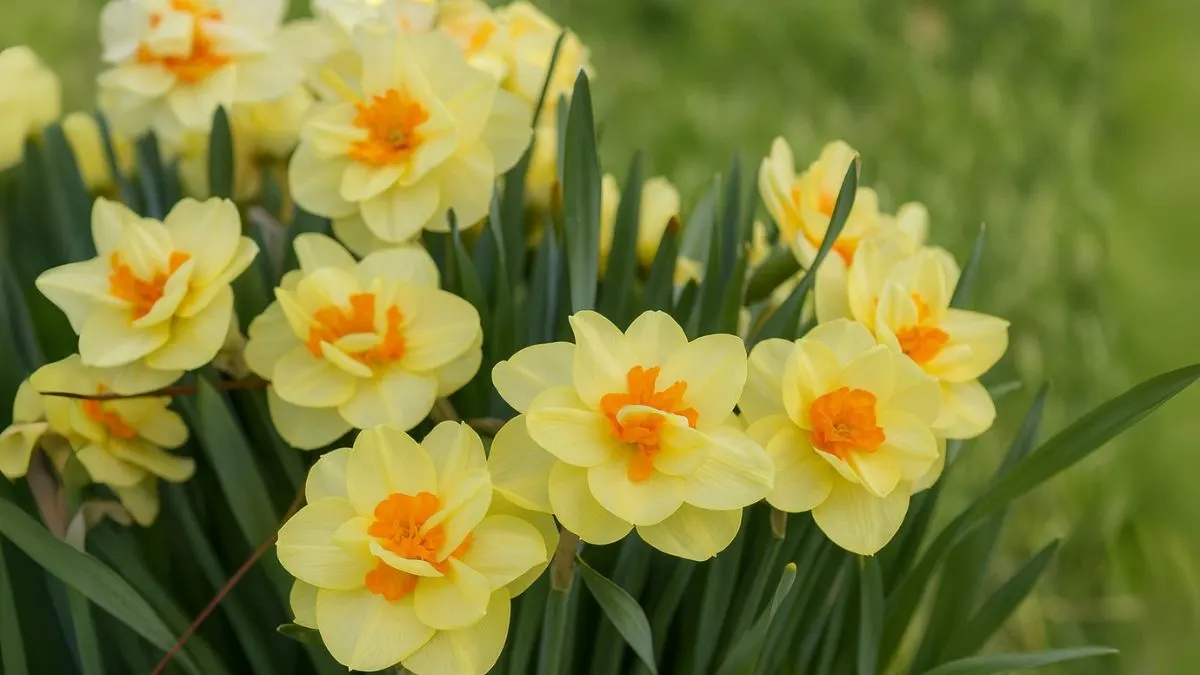There’s a reason daffodils, also known as Narcissus flowers, are loved in gardens across Canada, the USA, and around the world. Their golden, trumpet-shaped blooms symbolize renewal and the start of spring. Gardeners adore them not only for their cheerful appearance but also because daffodils are extremely easy to grow. With just a little planning, you can enjoy their blooms year after year.
In this guide, we’ll cover everything from soil preparation and bulb planting to light, water, and long-term care.
Why Daffodils Deserve a Place in Your Garden

- They are extremely easy to grow.
- They return year after year, requiring minimal effort.
- They’re adaptable, growing in both sunny and shady spots.
- Their beauty makes them one of the most popular ornamental spring flowers worldwide.
I still remember planting my first daffodil bulbs in my backyard in Toronto. By spring, my dull winter garden had transformed into a carpet of yellow and white blooms—it was magical.
Planting Daffodil Bulbs the Right Way
- When to Plant: It’s best to plant daffodil bulbs in autumn in moist but well-drained soil in full sun. Fall planting allows roots to establish before winter, ensuring healthy growth in spring.
- Where to Plant: Always start by choosing well-draining soil in the fall. Daffodils hate sitting in waterlogged conditions, which can rot the bulbs. Pick a sunny spot, though some varieties will also do well in dappled shade.
- Light and Location: Daffodil flowers like to follow the sun, so light is crucial. This means blooms often face the direction where sunlight is strongest. If you’re planting them near a fence or wall, orient bulbs so flowers will face your main viewing area.
That said, many gardeners are surprised to learn that daffodils thrive in low light, shady environments too. While they may not bloom as prolifically in deep shade, they’ll still bring bursts of color even under trees.
Also Read: Stachys Plant: Nature’s Soft Bandage With Healing Powers
Best Practice
- Daffodils prefer full sunlight and well-drained soil, so choose a location with at least 6 hours of direct sunlight when possible.
- In warmer regions like California or Florida, partial shade helps prolong bloom life.
Soil, Water, and Fertilizer
- Daffodils need moist but well-drained soil—never soggy. After planting, water the bulbs thoroughly to help roots establish. During growing season, water every 7–10 days if rainfall is lacking.
- Fertilizer Tip: A balanced fertilizer applied in fall and again after flowering boosts bulb strength for next year.
Care Aspect |
Recommendation |
Soil |
Well-drained soil, enriched with compost |
Sunlight |
Full sun, tolerates partial shade |
Watering |
Deep watering every 7–10 days |
Fertilizer |
Low-nitrogen bulb fertilizer, twice a year |
Seasonal Care
- Fall – Planting Time: Remember: plant them in well-draining soil in the fall for best results.
- Spring – Blooming Season: Once daffodils bloom, let the foliage die back naturally. Cutting it too early robs bulbs of stored energy.
- Summer – Dormancy: Leave bulbs undisturbed underground. If you’re container planting, store pots in a shaded, dry area until fall.
Also Read: The Secret Behind Rajnigandha Fragrance: How to Grow It at Home
Common Mistakes to Avoid
- Planting bulbs in soggy areas without drainage.
- Cutting foliage immediately after blooming.
- Expecting too much bloom in the first year—often, daffodils bloom best in year two onward.
Personal Gardening Tip
When I planted daffodils along a pathway in my garden, I made sure to stagger planting depths and group bulbs in clusters. The result? Waves of flowers blooming at slightly different times, extending the flowering season by weeks.
Growing daffodils is one of the most rewarding experiences for gardeners. Whether you choose to plant daffodil bulbs in autumn in moist but well-drained soil in full sun or try them in shaded spots, these flowers will bring joy every spring. They adapt to different conditions, proving that daffodils are extremely easy to grow.
From Canada to the USA and beyond, daffodils remain timeless favorites. So this fall, grab a bag of bulbs, plant them in well-draining soil, and get ready to welcome spring with radiant blooms.






